Best of Things, Mountain-Bikes -
The 8 Best Mountain Bikes Under $1000 in 2020
You’re in the market for a mountain bike and you have a budget of not more than $1,000?
Now, you’d probably be thinking,
- What type of mountain bikes are available at this price range?
- Hardtail or full suspension?
- What are the components used?
- SRAM or Shimano?
On this page, I’ll share with you some of the common things to expect in a mountain bike at this price range. Things such as type of mountain bike, frame materials, drivetrain, and tires.
A Quick Glance : Our Picks for Mountain Bikes Under $1,000
| Mountain Bike Models | Gearing | Fork Travel | Wheel Size |
|---|---|---|---|
| Specialized Rockhopper Expert | 1x9 | 100 mm | 2.3" |
| Cannondale Trail 5 | 2x9 | 100 mm | 2.25" |
| Trek X-Caliber 8 | 2x10 | 100 mm | 2.2" |
| Scott Scale 970 | 1x12 | 100 mm | 2.25" |
| Giant Talon 3 | 2x8 | 100 mm | 2.2" |
| GT Aggressor Expert | 3x8 | 80 mm | 2.25" |
| Diamondback Overdrive 2 | 2x9 | 100 mm | 2.25" |
| Kona Lava Dome | 2x9 | 100 mm | 2.25" |
Specialized Rockhopper Expert
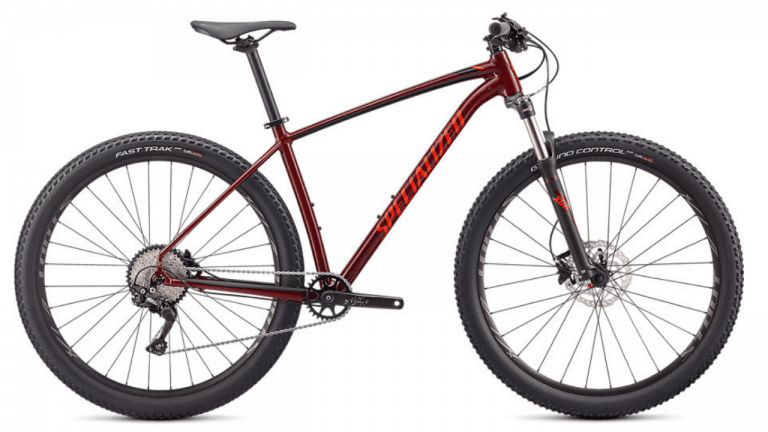
- Frame Material : Alloy
- Gearing : 9 Speed
- Weight : 12.8 kg
The Specialized Rockhopper Expert offers some nice upgrades from its lower-end model.
At the top of this list are Shimano Deore components, which are a significant step up from the Altus and Alivio components on other bikes at this price point.
Paired with these components are an 11-42T cog set and 30T front chainring.
The Rockhopper also has the unique feature of offering two different tire types, Specialized’s Ground Control Sport tires on the front and FastTrack Sport on the back. The two different mountain bike tires offer a combination of tread and fast roll.
Brakes are also on the higher end, with Shimano’s MT200 hydraulic disc brakes offer plenty of reliable stopping power. Specialized has also revamped its Rockhopper with higher-grade alloy, which means smaller tubes and less weight.
- Pros : Lifetime warranty coverage for the frames.
- Cons : Expect to pay more for the Specialized branding.
Cannondale Trail 5
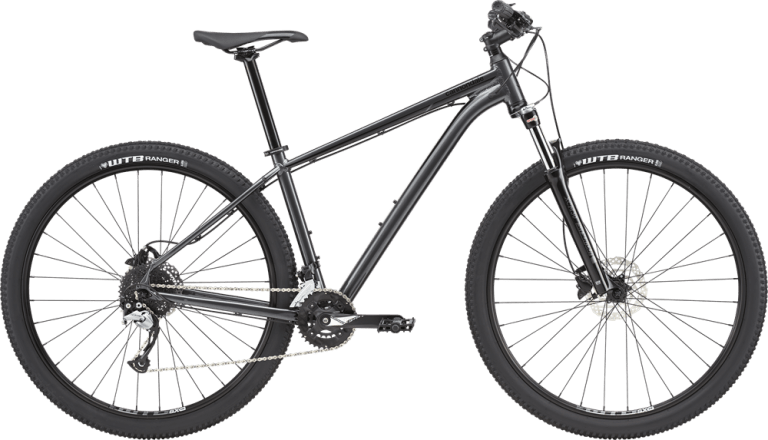
- Frame Material : Alloy
- Gearing : 9 Speed
- Weight : 14.7 kg
This hardtail mountain bike from Cannondale offers some excellent value at a price that’s well under $1,000.
Cannondale is known for frame designs that make for smooth rides. Such is the case with the Trail 5, which uses their proprietary Smartform C3 alloy construction. The short chainstays make for a shorter wheelbase that facilitates responsiveness and quick turns.
Components are a mix of Shimano Altus and Acera, which is a step up from the Cannondale Trail 8, which is fitted with mostly Tourney components. The FSA crankset includes a 36/22T chainring set-up while the rear cog set is a 9-speed 11-36T and a pair of Cannondale flat platform pedals.
Shimano’s MT200 hydraulic disc brakes offer excellent stopping power while the 29″ wheels include wide 2.25″ tires for traction. The front fork is the Suntour XCM-RL, which offers an adequate 100mm of travel in the Cannondale Trail 5.
- Pros : Very responsive handling for technical trails.
- Cons : Heavier than the average model in this price range.
Trek X-Caliber 8
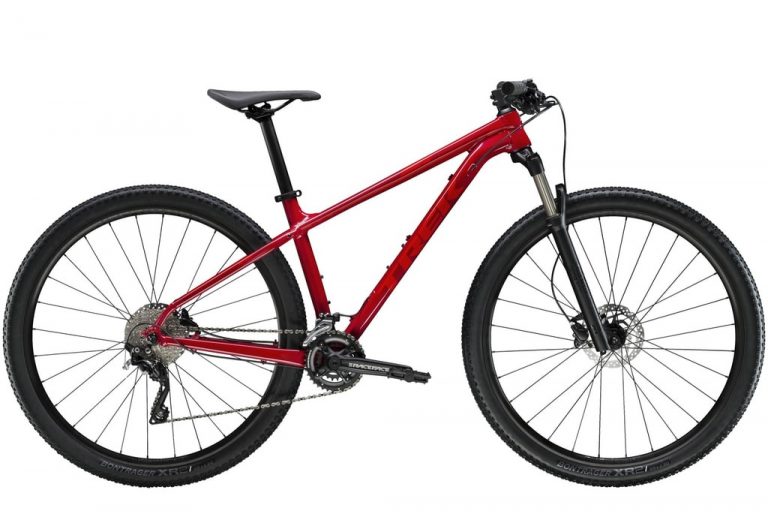
- Frame Material : Alloy
- Gearing : 10 Speed
- Weight : 13.4 kg
The Trek X-Caliber 8 does an excellent job of offering what most mountain bikers want at this price point, a bike that is aggressive enough to be race capable and relaxed enough for casual rides around town.
The Trek X-Caliber 8’s geometry features a steep seat tube and head tube angles coupled with a longer wheelbase, making it responsive enough for race use and stable enough for high-speed downhills.
Despite these qualities, the Trek X-Caliber 8 eschews the trend toward 1x drivetrains and instead sticks with a 36/22T double chainring coupled with a 10-speed rear cog set 11-36T.
The Trek X-Caliber 8 instead puts its money in the rear derailleur, which is the higher level Shimano Deore model. Other highlights include hydraulic disc brakes, Bontrager MTB saddle, and 2.2″ Bontrager XR2 mountain bike tires.
- Pros : 10-speed drivetrain with a dual front chainring.
- Cons : Expect to pay more for the Trek branding.
Scott Scale 970
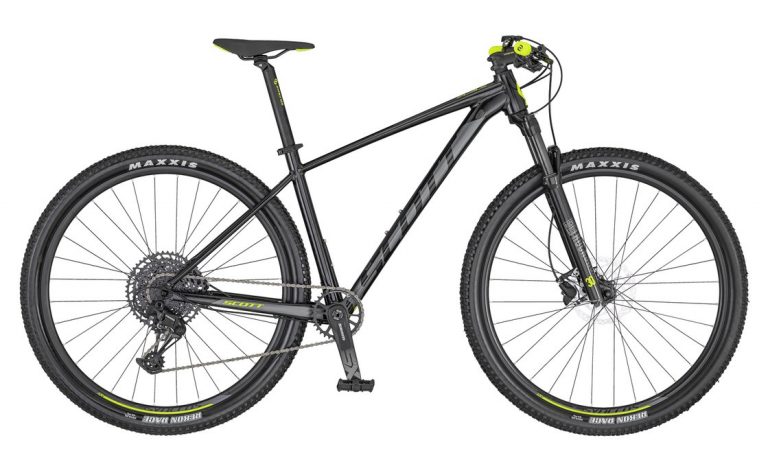
- Frame Material : Alloy
- Gearing : 12 Speed
- Weight : 12.7 kg
The Scott Scale 970 features SRAM’s latest entry into the 1×12 speed market, the SRAM XS Eagle components, which make up the bike’s rear derailleur.
And yes, this features a full 12-speed rear cogset with a gigantic range of 11-50T. This cogset is paired with a single front 32T chainring. Other features on the Scott Scale 970 include Shimano disc brakes and a RockShox Silver fork with 100mm of travel.
The Scott Scale 970 is also fitted with Scott’s patented remote RideLoc system, which allows you to unlock the fork for flats and downhills and lock it for more stiffness for uphills without having to take your hands off the handlebar grips.
- Pros : Excellent value for money in terms of overall weight and components’ quality.
- Cons : Stock availability can be limited.
Giant Talon 3
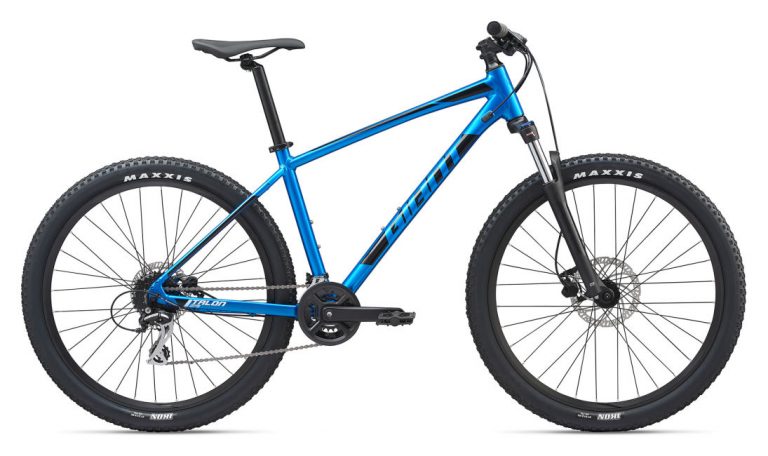
- Frame Material : Alloy
- Gearing : 9 Speed
- Weight : 15.0 kg
The 27.5” Giant Talon 3 offers several value-adds at a price point that puts it just outside the sub $500 price range.
The Giant Talon 3’s relaxed frame geometry makes this a great starter bike for x-country mountain biking and trail riding. The drivetrain is full Shimano with Altus shifters and an 8-speed Acera rear derailleur with a 12-32T range and a 36/22T double chainring.
Other highlights include Tektro hydraulic disc brakes and a Suntour front fork with 100mm of travel. Wheels are 27.5” with beefy 2.2” thick mountain bike tires. It comes in metallic blue and olive green colors.
The Giant Talon 3 is an excellent deal from one of the largest and most respected bike manufacturers globally.
- Pros : Excellent value for money. Priced cheaper than most models.
- Cons : Very heavy.
GT Aggressor Expert
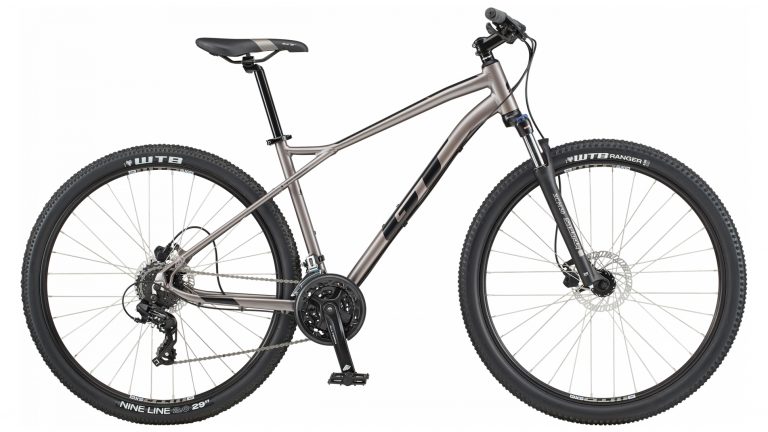
- Frame Material : Alloy
- Gearing : 8 Speed
- Weight : 14.0 kg
The GT Aggressor features GT Bikes’ patented triple triangle frame technology that the company was built on.
The design essentially shrinks the frame’s rear triangle by creating floating chainstays that don’t connect to the seat post, making the bike more responsive, stiff, and durable.
In addition to a solid frame, it features mechanical disc brakes, an 8-speed Shimano Altus rear derailleur, and a SunTour fork with lockouts. GT has also set up the Aggressor Expert with WTB Ranger Comp tires, allowing it to handle both dirt and street competently.
With the GT Aggressor Expert, you get a budget-priced mountain bike that is nimble enough to handle technical singletracks.
- Pros : 24 gears are more than enough to tackle all types of terrains.
- Cons : Limited colors.
Diamondback Overdrive 2
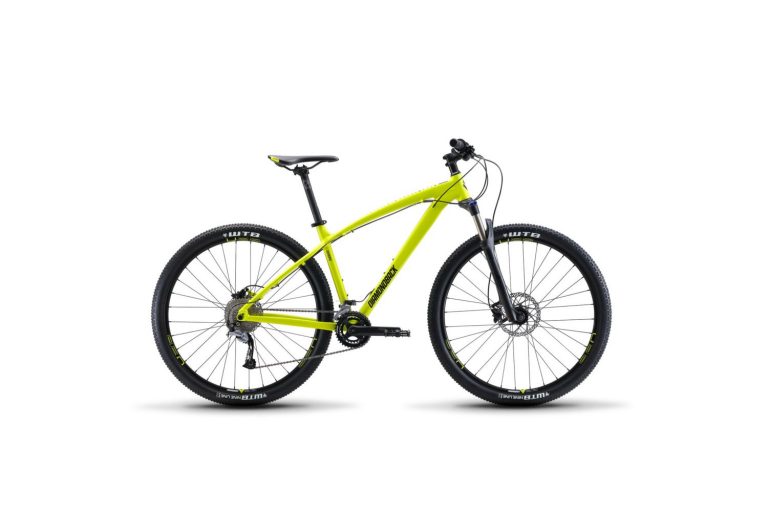
- Frame Material : Alloy
- Gearing : 9 Speed
- Weight : 14.5 kg
Expect to find a lot of value in the components and brakes on Diamondback’s mountain bikes.
This is one of the perks of buying from a company that doesn’t have the established name that bigger companies like Specialized, Trek, and Giant have.
The Diamondback Overdrive 2 offers some great features at a budget price including a 2×9 drivetrain with a Shimano Alivio and Acera front and rear derailleur. The gearing combination gives you enough gears to tackle most of the cross-country trails except those very steep climbs.
The RockShox Judy Silver fork, meanwhile, offers a full 100mm of travel.
- Pros : Good value in terms of components used vs price.
- Cons : Color choices might not suit some.
Kona Lava Dome
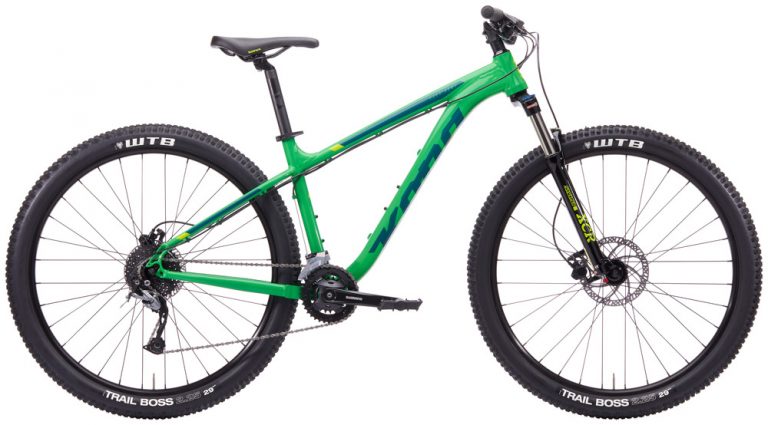
- Frame Material : Alloy
- Gearing : 9 Speed
- Weight : 15.0 kg
At 15 kg, the Kona Lava Dome comes in at a higher weight than most other bikes at this price point. That said, the Lava Dome has a lot to offer.
The bike is manufactured by Washington-based Kona, which has been making bikes since 1988. The Lava Dome is equipped with an 11-36T, 9-speed rear cogset, and 36/22T chainrings. Components are a mix of Shimano Altus and Alivio.
A small triangle in the rear coupled with a steep head tube angle makes for excellent handling and control on downhills, while the hardtail still makes climbing very manageable.
The Kona Lava Dome is fitted with 2.25” wide Trail Boss tires, which are more than capable of handling tough single-track terrain. Brakes on the Kona are Tektro mechanical with a pair of alloy flat pedals.
- Pros : Plenty of traction with its 2.25″ wide WTB Nine line tires.
- Cons : Stock availability could be limited.
What to Expect in A Mountain Bike Under $1,000

Wondering what you can get in a mountain bike at the $1,000 price point?
This section below will give you a rough idea of what to expect at this price range for everything from frame materials to drivetrain and wheelsets.
1. Type of Mountain Bikes
Just as there are subsections of road bikes, there are also subsections of mountain bikes. And since the terminology is a bit vague, it can be difficult to understand which bike is for what need.
The majority of the bikes you’ll find on this list are classified as hardtail bikes.
What are hardtails?
As the name suggests, hardtails have a suspension on the front fork but no suspension in the bike’s rear. In most bikes, the fork will have a travel of 100mm. In some cases, the fork has a longer trip up to 120mm.
A hardtail is generally used for either cross country (XC) or trail riding.
Cross Country Riding
Cross country is what some refer to as the purest form of mountain biking, which is riding meandering trails specifically designed for mountain biking use. These trails might be hard-packed, loose dirt, or gravel with such obstacles as tree roots and small logs.
Dual suspensions aren’t necessary here and may reduce performance with too much power given away flex during pedaling. Rear suspensions also generally add weight. As such, it’s better to trade the expense of a dual suspension bike for a lighter weight hardtail with a higher-end drivetrain.
Trail Riding
Trail riding is a step up from cross country in that it involves more technical riding.
Trail bikes fall in between cross country riding and all-mountain bike riding. They are designed for flats, descents, and climbs. Expect more dual-suspension bikes for trail riding with a large gear range for taking on whatever terrain one might encounter.
Read More : Hardtail vs Full Suspension MTB
2. Frame Materials
At this price point, you don’t have much of a choice when it comes to the frame material.
Aluminum is pretty much the only material you’ll find.
Highly prized carbon frames start at a significantly higher price point, usually from $2,000 onwards. That said, expect the aluminum alloy’s quality and the construction of the frame to be a step up from entry-level aluminum frames.
3. Components, Drivetrain and Brakes
When it comes to drivetrain, expect to find a broad range of configurations as many models can be either specced with 1x or 2x front chainrings.
Most rear cog sets at this price point will be either 9 or 10 speed, a step up from the 7 or 8-speed cassettes you find on cheaper mountain bikes, especially those below $500.
You’ll even find the occasional 1×12 gear set up on such bikes as the Scott Scale 970 and Specialized Rockhopper.
For most doubles, expect a rear cog set with a range of 11-36T. A rear cassette with an 11-42T or even as high as 50T is typical for a 1x set up.
What makes one better than the other?
Personal preference is really at play here. However, 1x drivetrains have gained a following due to ease of use, especially for a beginner mountain biker. Executing a front derailleur shift while barreling down singletracks is a heck of a lot harder than flicking your thumb for a rear derailleur shift. The 1x drivetrains are also lower maintenance as no front derailleur is required.
Most mountain bikes below $1,000 have graduated from your standard mechanical disc brakes to higher performance hydraulic brakes. Rotor sizes are also larger on these bikes, with a minimum of 160mm in diameter.
You might even find some brakes with 180mm rotors, such as the Scott Scale 970 and Diamondback Overdrive 2.
Why does this matter?
The bigger the rotor, the better the stopping power.
Read More : A Guide to Understanding Bicycle Disc Brakes
4. Tire and Wheel Size
Tire size options are pretty much standard across all price points for mountain bikes.
As such, expect to find plenty of selection in both the 27.5” and 29” wheel sizes for sub $1,000 mountain bikes. For some models, such as the Trek X-Caliber 8, the wheel size is dependant on the frame size. A bigger frame will use a 29″ wheelset, while a smaller frame will have a 27.5″ wheelset.
Tire widths will be a little beefier than lower-priced bikes to handle tougher terrain. Expect to find tires up to 2.3” wide.
5. Total Weight
Lighter wheelsets, components, and frames mean less overall weight for bikes at this price range than more cheaply price ones. You can expect the ride quality to be much better too.
Expect to find bikes in the weight range of 12 to 14 kg in the sub $1,000 market.
Read More : Why You Should Pay Attention to Bike Frame and Wheels Weight Limits
Author Recommended Reads
